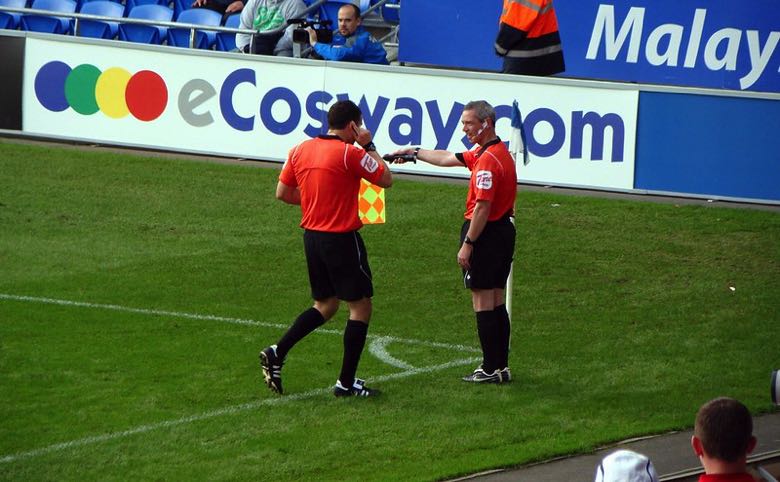Most sports will come with a huge range of terminology that seems like it is almost designed to confuse people that are new to that sport. Of course, this is not the case, but some sports, like American Football or cricket seem to have been designed to be complicated.
One such rule in football that divides fans is the offside rule. Of course, if you are into football or you have ever watched a game, you will have heard about the infamous offside rule, but what is it? In this guide, we will delve into the world of offsides as we look to detail everything you will ever need to know about the offside trap and more. First of all, we need to take a look at what the offside rule is.

bet365 6 SCORES CHALLENGE
Predict scores to win cash prizes!
Win cash prizes by predicting the scores of just six Soccer matches, with 6 Scores Challenge at bet365! All is not lost if you fall short on one or two results, prizes are on offer for three, four and five correct results.
The prize value displayed for six correct predictions is the maximum available based on a single winner in that round and will be reduced in the event of a shared prize-pool.
What Is the Offside Rule?

The offside rule is a law in football that stops players from simply standing by the goal as they look to ‘goal-poach’. You will have likely seen this all too often if you played football in school or at your local park, with a player wanting to star as the striker by scoring all of the goals without having to do any of the running.
In any kind of football that is following the standard rules set out by the FA, the offside rule will be in effect. The offside rule stipulates that a player is in an offside position if:
- Any part of the head, feet or body is in the opponents half (excluding the half-way line)
- Any part of the head, feet or body is nearer to the opponent’s goal than both the ball and the second-last opponent.
It is important to note that the hands and arms of all players (goalkeepers included) are not considered. Usually, the armpit is the first part of the arm that is considered when determining an offside call.
When a Player Is Onside (Not Offside)
A player is deemed to be onside (not offside) if they are level with:
- The second-last opponent
- The last two opponents
A player cannot be offside from a:
- Goal-kick
- Throw-in
- Corner kick
This means that an attacking player can be anywhere in the opposition’s half, and they will not be penalised if the ball goes through to them. This is why you will sometimes see players closer to the opposition’s goal than the last defender from a goal-kick or throw-in as the attacking player is trying to exploit the fact that they cannot be penalised for being offside.
If a player is deemed to be offside, then the referee will blow their whistle and signal an offside offence. The defending team will receive an indirect free-kick at the point where the offence occurred (where the attacking player touches the ball).
The Offside Trap
The offside trap is a defensive play that a side will use as they try to halt the opposition’s attack before it can get towards being of any real danger. The basic idea behind the offside trap sees the defensive players all look to step up the pitch just before a pass is made to the leading attacking player. This means that, if done correctly, the only player between the attacking player and the goal is the goalkeeper, with all other defensive players now further away from their own goal than the attacking player.
Attacking Players
This would therefore result in the attacking player making a pass to their forward with the latter in an offside position, therefore seeing the attack brought to an end with a free-kick awarded to the defending side. Of course, the defending team has to be careful when looking to play the offside trap. If even a single defender is a little slow to play the offside trap or they are not on the same wavelength as their teammates, then this could see the forward played onside by the last man, giving them a free run at goal with the ball.
Defending Players
Similarly, if the attacking player with the ball is suspicious that the defending team is about to play the offside trap, then they can hold onto the ball as the defending team steps up. The player with the ball can then wait for the attacking player to get back into an onside position before playing the ball through as they look to take advantage of the defending team being flat-footed or out of position.
A Risky Move
Changes to the law across the history of the game have meant that using the offside trap has become increasingly risky. This is due to the fact that inactive players will not be flagged as offside if they are not interfering with play. Therefore, if an attacking player ghosts in at the last minute from an onside position and latches onto a ball meant for a player that was offside, then they would not be penalised. The variables in play when it comes to playing the offside trap are such that teams have edged away from using it as it can often leave a side looking very foolish if it is not used perfectly.
Who Calls an Offside?

In less official football matches, the referee may look to call an offside, but they will not usually be in the right position to do so due to the fact they will be trying to keep up with play in the middle of the pitch. They will also have to try to keep an eye on every part of the game as it progresses, meaning they will not always see whether a player started in an offside position.
Assistant Referees
Usually, the assistant referees will call offsides. The assistant referees are two officials that stand on opposite touchlines. One will stand at the far end of the pitch and traverse one half, while the other assistant referee will be on the closer side of the pitch as they run the line in the other half.
If a player is judged by them to be offside, then they will raise their flag and before pointing it straight in front of them to show there has been an offside offence. In the modern game in a league like the Premier League, if an assistant referee is not completely sure that a player is offside, they will be asked to keep their flag down and follow play, waiting until the ball has gone dead.
VAR Often Used
The assistant referee will then flag for an offside. If the ball has gone dead without a goal being scored, then this will not seem like a major issue. However, if a goal is scored and the assistant referee then goes back to flag for an offside, this is usually met by derision from the fans of the team that has scored. In most cases in the biggest leagues, VAR will then be used to judge whether or not there has been an infringement (offside or otherwise).
History of the Offside Trap
Pioneered by Notts County, the offside trap was brought into the game in the 1900s and it became a viable way for a defensive side to try to stop an opposition’s attack from proceeding any further by putting the attacker in an offside position. The offside trap became useful as the offside rule was simplified and made less problematic. This would see almost all strikers in an offside position, whether being able to gain an advantage, interfering with play or not interfering at all, likely to be penalised.
Notable Users
Notable users of the offside rule were legendary Argentine coach Osvaldo Zubeldia and former-AC Milan coach Arrigo Sacchi. However, most recently, the offside trap has been utilised by Jurgen Klopp and Liverpool. Klopp’s offside trap is predicated on the speed at which his three centre-halves can move up the pitch.
Virgil van Dijk has led the defensive line for the Reds for years and he, alongside other fast defenders, can step up and catch the opposition’s attack in an offside position. Impressively, Liverpool are reported to have caught almost double as many opponents offside as any other Premier League team managed in the 2021/22 season.
Best Used by Defending Team on Same Wavelength
The offside trap is best used by a defending team that are full of quick players that are on the same wavelength. If a single player is a little slow to step up then this could result in the offside trap failing and the attacking team having a free run at goal.

